In electronic devices, heat is generated as a result of various processes, such as power dissipation and electrical resistance. If this heat is not dissipated efficiently, it can cause the device to malfunction, reducing its lifespan and affecting its performance. To prevent this from happening, heat sinks are commonly used in electronic devices, especially in printed circuit boards (PCBs).
In this article, we will delve deeper into the world of heat sinks in PCBs, exploring their design, materials, types, and applications. We will also discuss the importance of proper heat sink placement and thermal management in electronic devices. By the end of this article, readers will have a better understanding of how heat sinks work and why they are crucial in electronic device design.
What Is a Heat Sink in a PCB?
The heat sink absorbs the heat generated by the component and dissipates it into the surrounding air, thereby preventing the temperature from rising to a level that could damage the component.
Heat sinks come in various shapes and sizes, and their effectiveness depends on factors such as the material used, the surface area, and the airflow around them. In a PCB, heat sinks are typically used in conjunction with other cooling techniques, such as fans and thermal paste, to ensure that the device operates within safe temperature limits.

Benefits of Heat Sink PCBs Over Traditional PCBs:
Passive Heat Exchange
One of the key benefits of heat sink PCBs is their ability to provide passive heat exchange. Traditional PCBs rely on fans or other active cooling systems to manage heat, which can be noisy and require additional space and power. Heat sink PCBs, on the other hand, rely on the natural convection of air to dissipate heat, making them quieter and more efficient.
Maintains Thermal Stability
Heat sink PCBs also help to maintain thermal stability in electronic circuits. By spreading heat evenly across the board, heat sink PCBs prevent hotspots from forming and ensure that components are operating at a consistent temperature. This helps to prevent damage to electronic components and extends their lifespan [2].
Spreads Heat
Another advantage of heat sink PCBs is their ability to spread heat across a larger surface area. Traditional PCBs typically have limited space for heat dissipation, which can lead to the accumulation of heat in specific areas. Heat sink PCBs, on the other hand, have a larger surface area for heat dissipation, which helps to spread heat evenly across the board and prevent hotspots.
Prevents System Failure
Finally, heat sink PCBs help to prevent system failure in electronic circuits. High temperatures can cause electronic components to malfunction or even fail, leading to costly repairs or replacements. Heat sink PCBs prevent overheating and ensure that components are operating within their safe temperature range, reducing the risk of system failure.
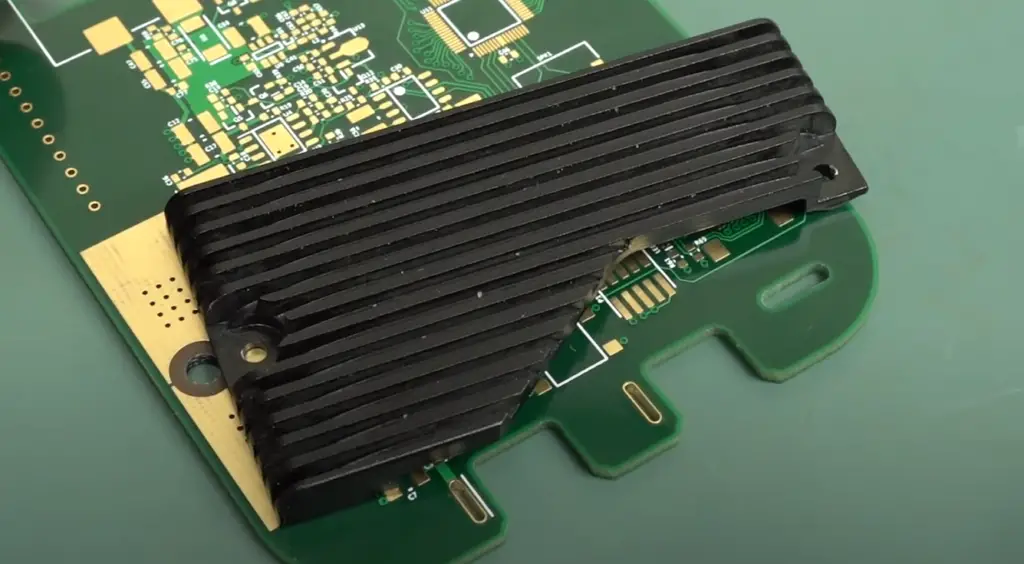
Characteristics of a Good Heat Sink:
Thermal Conductivity
Thermal conductivity is the most important characteristic of a good heat sink. It refers to the ability of the heat sink material to conduct heat away from the source. A material with high thermal conductivity is more efficient at transferring heat away from the electronic component, resulting in lower temperatures and better performance. Copper and aluminum are commonly used materials for heat sinks due to their high thermal conductivity.
Surface Area
The surface area of a heat sink is another important characteristic. A larger surface area provides more space for heat dissipation, resulting in better performance. Heat sinks with fins or other protrusions increase the surface area, improving their effectiveness at dissipating heat.
Fin Density
The density of fins on a heat sink is also an important characteristic. Higher fin density increases the surface area of the heat sink, allowing for better heat dissipation. However, higher fin density can also increase air resistance and reduce airflow, which can decrease heat dissipation. It is important to find the right balance between fin density and airflow for optimal heat dissipation [3].
Airflow
Airflow is another important characteristic of a good heat sink. Adequate airflow is necessary to remove the heat from the heat sink and dissipate it into the surrounding environment. Heat sinks can be designed with different shapes and sizes to optimize airflow and improve heat dissipation.
Compatibility
The compatibility of a heat sink is another important consideration. A heat sink must be designed to fit the electronic component it is intended to cool. It is important to consider the size, shape, and orientation of the component when selecting a heat sink. A heat sink that is not compatible with the electronic component may not be able to dissipate heat effectively, leading to overheating and component failure.
Ease of Installation
Finally, the ease of installation is an important characteristic of a good heat sink. A heat sink that is easy to install and remove can save time and reduce the risk of damage to electronic components. Heat sinks with clips or other attachment mechanisms can be easier to install than those that require adhesives or other bonding agents.
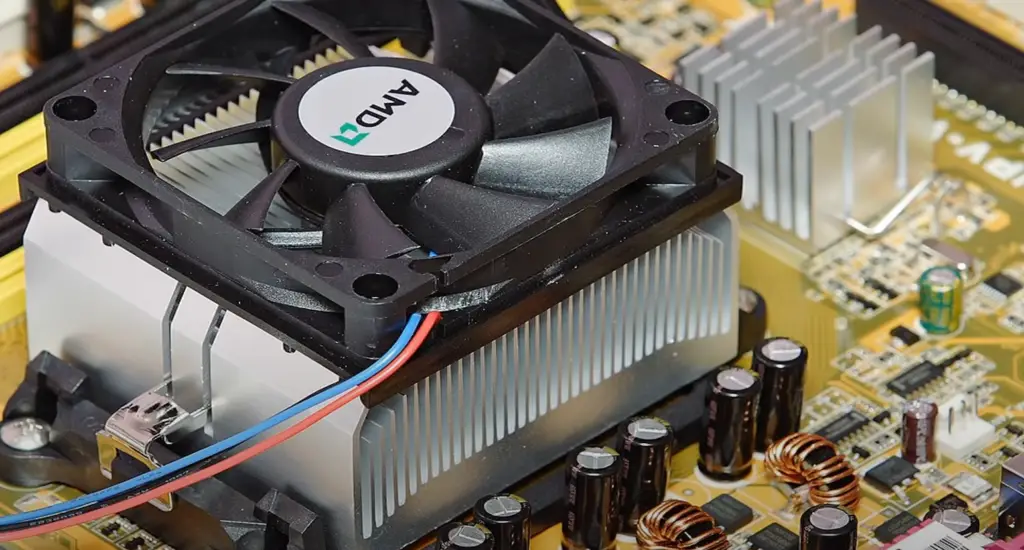
Why Are Heat Sink PCBs So Popular:
Improved Thermal Management
Heat sink PCBs are designed to dissipate heat away from electronic components, thus preventing overheating and improving their performance. They have a larger surface area than traditional PCBs, which allows for greater heat dissipation. Additionally, the use of thermally conductive materials in heat sink PCBs helps to transfer heat more efficiently.
Space Savings
Heat sink PCBs can save valuable space in electronic circuits as they combine the functions of a PCB and a heat sink into a single component. Traditional heat sinks often take up significant space in electronic circuits, which can be a constraint in small devices.
Cost Savings
The use of heat sink PCBs can result in cost savings as they eliminate the need for a separate heat sink component. This can lead to reduced manufacturing costs and a smaller bill of materials [4].
Improved Reliability
Heat sink PCBs improve the reliability of electronic circuits by reducing the risk of component failure due to overheating. By dissipating heat away from components, heat sink PCBs ensure that they operate within their specified temperature range, improving their lifespan and performance.
Versatility
Heat sink PCBs can be designed to fit a variety of electronic components, including LEDs, transistors, and power supplies. This versatility allows for their use in a wide range of applications, from consumer electronics to industrial equipment.
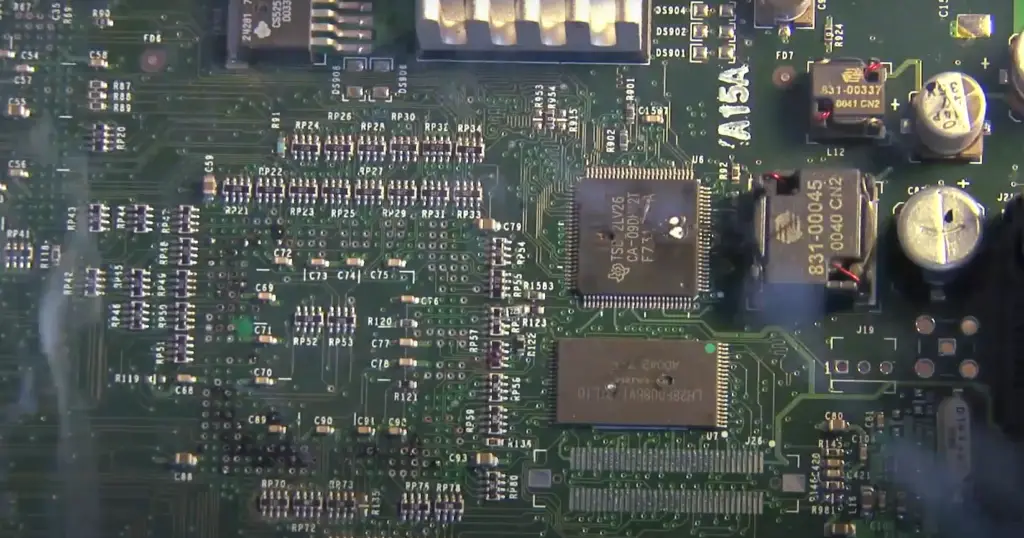
Ease of Installation
Heat sink PCBs are easy to install and can be designed to fit a variety of mounting options. This simplifies the assembly process and reduces the risk of damage to electronic components during installation.
Environmental Friendliness
Heat sink PCBs can be made from environmentally friendly materials such as aluminum, which is a highly recyclable material. Additionally, the improved thermal management provided by heat sink PCBs reduces the energy required for cooling, resulting in improved energy efficiency and reduced environmental impact.
Applications of Heat Sink PCBs:
LEDs
LEDs generate significant amounts of heat, especially in high-power applications such as lighting and displays.
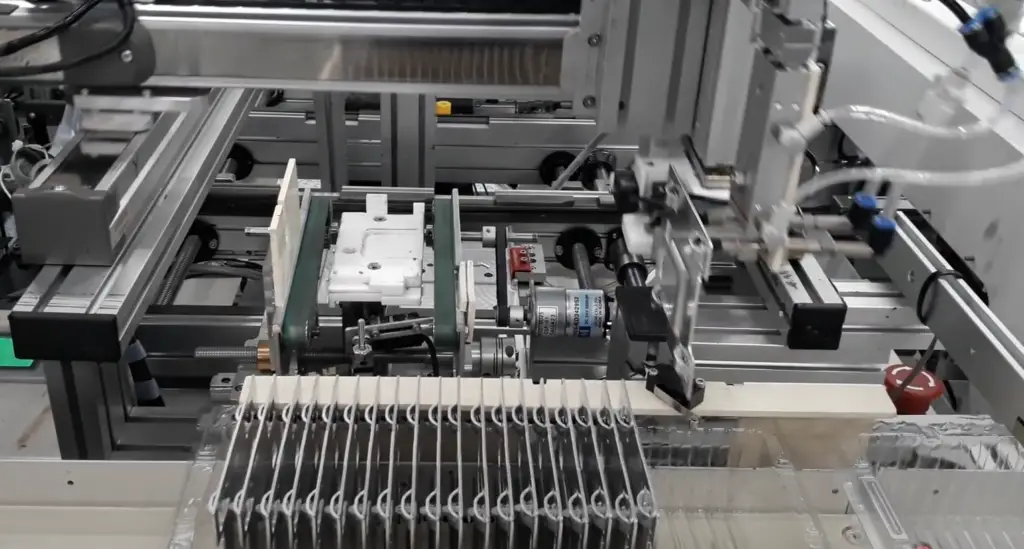
Computers
Computers and other electronic devices rely on efficient heat management to prevent system failure and maintain reliable operation. Heat sink PCBs can be used in computers to manage the heat generated by components such as CPUs and GPUs, ensuring stable performance and reducing the risk of damage or failure.
Industrial Facilities
Industrial facilities often rely on electronic equipment for critical operations such as process control and automation. Heat sink PCBs can be used to manage the heat generated by these components, ensuring their reliable operation and reducing the risk of system failure. This is particularly important in harsh environments where electronic components may be exposed to high temperatures, dust, or other contaminants.
Soldering
Soldering is a critical process in the manufacture of electronic components and circuits. Heat sink PCBs can be used to manage the heat generated during soldering, preventing damage to electronic components and ensuring their reliable operation [6].
Consumer Products
Heat sink PCBs can also be found in a variety of consumer products such as televisions, audio equipment, and home appliances. These products rely on efficient heat management to prevent system failure and maintain reliable operation. Heat sink PCBs can be used to manage the heat generated by components in these products, ensuring stable performance and extending their lifespan.
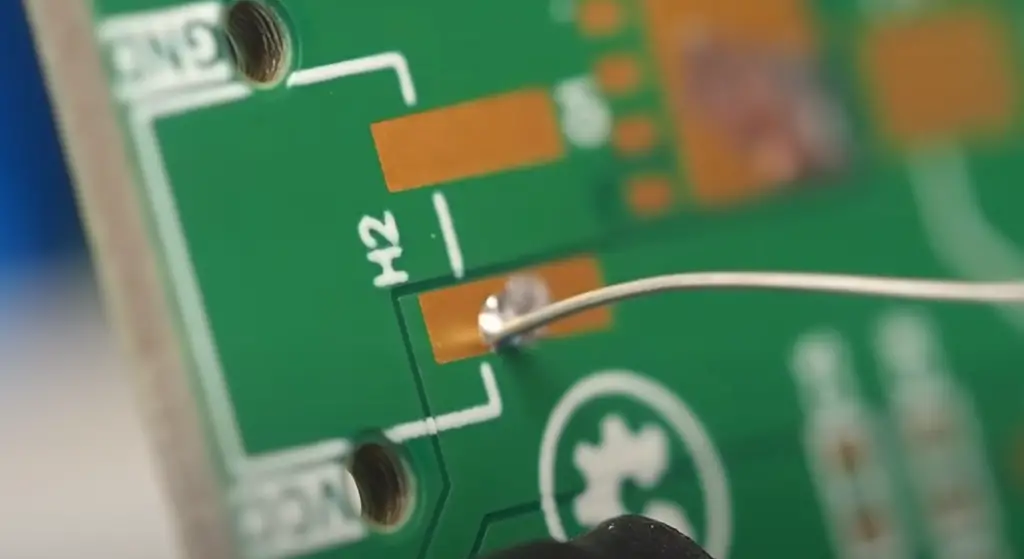
2 Major Types of Heat Sinks:
Passive Heat Sink
A passive heat sink is the simplest form of a heat sink. It is typically made of metal, such as aluminum or copper, and helps to dissipate the heat generated by a PCB component by radiating it into the surrounding environment. This type of heat sink does not require any power to operate and functions passively.
Active Heat Sink
An active heat sink requires an external source of power in order to function properly. These are usually much larger than passive heat sinks and can be designed with fans, pumps, or other forms of forced air convection for increased cooling efficiency. Active heat sinks may also utilize liquid cooling systems or vapor chambers for extra thermal management capabilities. In addition, some active heat sinks are even equipped with temperature sensors and thermal controllers for improved temperature regulation [7].
Types of Heat Sink Based on Material:
Aluminum Heat Sink
Aluminum is the most commonly used material in heat sink construction. The advantages of aluminum heat sinks are their low weight, good thermal conductivity, and relatively low cost. Aluminum heat sinks can be manufactured using various processes such as extrusion, forging, and die casting. Extruded aluminum heat sinks are the most popular due to their low cost, ease of manufacturing, and the ability to produce customized shapes. Aluminum heat sinks are typically used in low-power applications, such as computer processors and LED lights.
Copper Heat Sink
Copper is a metal with excellent thermal conductivity and is the second most commonly used material in heat sink construction. Copper heat sinks are more expensive than aluminum heat sinks but offer better thermal performance, making them suitable for high-power applications. Copper heat sinks can be manufactured using the same processes as aluminum heat sinks, including extrusion and forging.
Pinned Heat Sink
The pins are typically arranged in a uniform pattern on the heat sink’s surface, creating a large number of heat transfer points. Pinned heat sinks can be manufactured using different materials, including aluminum and copper.
Finned Heat Sink
The fins are typically arranged in a uniform pattern on the heat sink’s surface, creating a large number of heat transfer points. Finned heat sinks can be manufactured using different materials, including aluminum and copper. Finned heat sinks are commonly used in high-power applications, such as power supplies and motor drives [8].
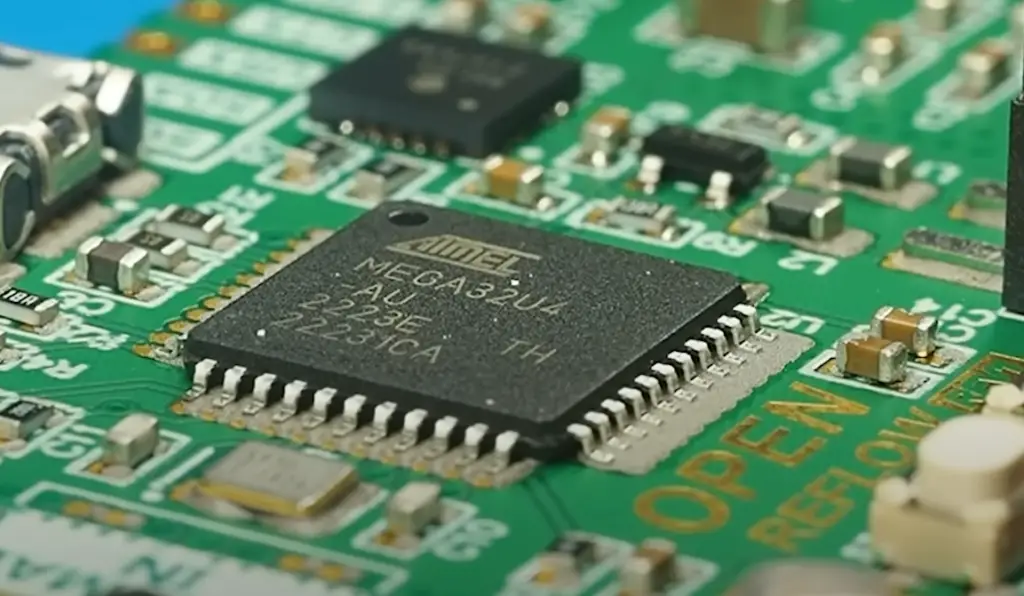
Heat Sink Types Based on Manufacturing Techniques:
Stamped Heat Sinks
The process involves creating a mold and stamping it into a flat sheet of metal, such as aluminum or copper. The stamped heat sink is then cut and bent into its final shape. Stamped heat sinks are commonly used in low-cost applications such as consumer electronics, automotive, and lighting.
Bonded Heat Sinks
Bonded heat sinks are created by bonding two dissimilar materials together, typically copper and aluminum. The process involves using a high-temperature adhesive to bond the two materials together. Bonded heat sinks offer a high level of thermal performance and are commonly used in high-power applications such as power supplies and LED lighting.
Skived Heat Sinks
Skived heat sinks are created by skiving a thin sheet of metal, typically copper or aluminum, using a blade or knife. The process involves removing small sections of metal from the sheet in a pattern, creating a series of fins. Skived heat sinks offer a high level of thermal performance and are commonly used in high-power applications such as servers and telecom equipment.
Swaged Heat Sinks
Swaged heat sinks are created by using a hydraulic press to form a thin sheet of metal into the desired shape. The process involves applying pressure to the metal sheet, forcing it into a die. The die creates a series of fins on the metal sheet. Swaged heat sinks offer excellent thermal performance and are commonly used in high-power applications such as power amplifiers and inverters [9].
Forged Heat Sinks
Forged heat sinks are created by heating a metal billet and then using a press to shape it into the desired shape. The process involves applying pressure to the heated metal, forcing it into a die. The die creates a series of fins on the metal. Forged heat sinks offer excellent thermal performance and are commonly used in high-power applications such as automotive and aerospace.
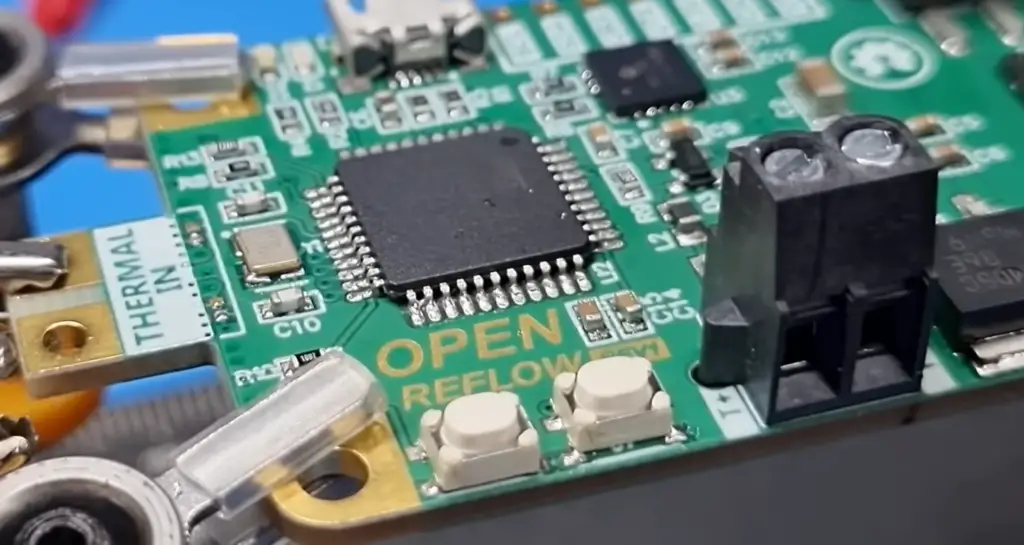
Machining Heat Sinks
Machining heat sinks are created by machining a block of metal into the desired shape. The process involves using a computer-controlled machine tool to remove excess material from the metal block. Machining heat sinks offer excellent thermal performance and are commonly used in high-power applications such as industrial machinery and medical equipment.
Extruded Heat Sinks
Extruded heat sinks are created by extruding a block of metal, typically aluminum, through a die to create the desired shape. The process involves applying pressure to the metal, forcing it through a shaped opening. Extruded heat sinks offer excellent thermal performance and are commonly used in high-power applications such as LED lighting and power supplies.
CNC Machined Heat Sinks
CNC-machined heat sinks are created by using a computer-controlled machine tool to remove excess material from a block of metal. The process is similar to machining heat sinks, but the computer-controlled machine tool allows for a higher level of precision and accuracy. CNC-machined heat sinks offer excellent thermal performance and are commonly used in high-power applications such as aerospace and defense.
Factors to Consider in Heat Sink Design:
Heat Sink Materials
The choice of materials for a heat sink is important as it can affect the thermal performance, weight, cost, and manufacturing process of the heat sink. Common materials used for heat sinks include aluminum, copper, and their alloys. Aluminum is a popular choice due to its low cost, lightweight, and ease of manufacturing. However, copper has higher thermal conductivity than aluminum, which means it can dissipate heat more efficiently. Copper is also more expensive and heavier than aluminum.
Other materials such as graphite, diamond, and ceramics have also been used for heat sinks due to their high thermal conductivity. However, these materials are more expensive and difficult to manufacture, making them less common in heat sink design.
Heat Sink Fins
The design of heat sink fins is crucial for the thermal performance of the heat sink. Fins increase the surface area of the heat sink, which improves the heat transfer from the heat sink to the surrounding environment. The design of the fins can also affect the pressure drop and airflow resistance of the heat sink.
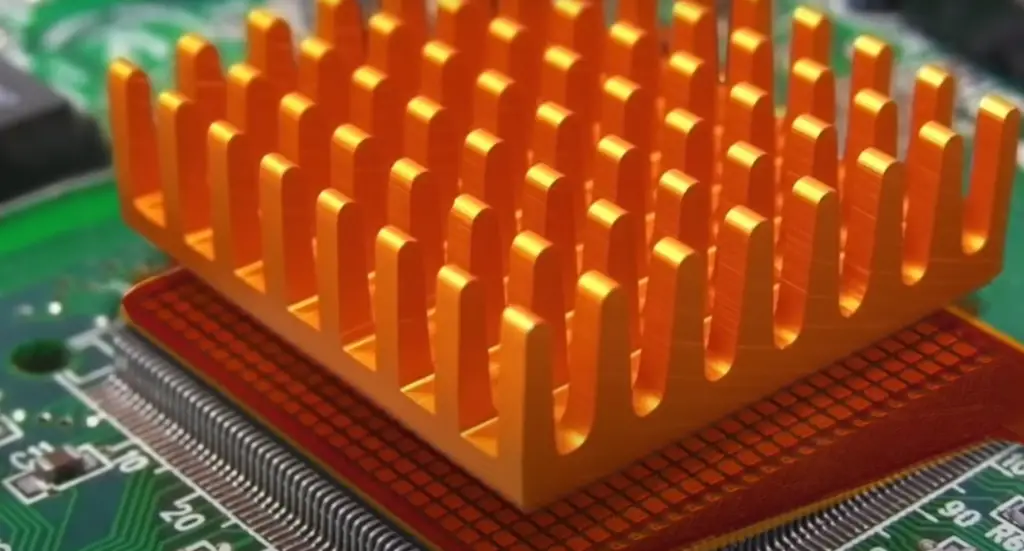
The size, shape, and spacing of fins should be carefully considered in heat sink design. Fins that are too thin or too close together can increase the pressure drop and reduce the airflow, which can reduce the effectiveness of the heat sink. Fins that are too thick or too far apart can reduce the surface area of the heat sink, which can also reduce the effectiveness of the heat sink.
Thermal Resistance
In heat sink design, thermal resistance is used to calculate the thermal performance of the heat sink. The lower the thermal resistance, the more effective the heat sink is at dissipating heat.
Thermal resistance is affected by several factors, including the choice of materials, the design of fins, and the attachment methods used. To calculate the thermal resistance of a heat sink, the designer needs to consider the thermal conductivity of the materials, the surface area of the heat sink, and the airflow around the heat sink [10].
Attachment Methods
Attachment methods are crucial in heat sink design as they affect the thermal performance, reliability, and manufacturing process of the heat sink. There are several attachment methods used in heat sink design, including thermal adhesives, screws, clips, and clamps.
Thermal adhesives are commonly used in low-power applications where the heat generated by the component is low. The adhesive is applied between the heat sink and the component, and it cures to form a strong bond. However, thermal adhesives can be difficult to remove, which can make it challenging to replace or repair the component.
Screws, clips, and clamps are commonly used in high-power applications where the heat generated by the component is high. These attachment methods allow for a tight and secure connection between the heat sink and the component. However, they can be more challenging to install and remove than thermal adhesives.
PCB Heat Dissipation Techniques:
Use Cooling Fans and Heat Sinks
Cooling fans and heat sinks are commonly used in electronic devices to dissipate heat generated by the PCB. A cooling fan helps to improve the airflow around the PCB, which, in turn, helps to remove the heat generated by the components. Heat sinks are devices that absorb heat from the PCB and then dissipate it into the surrounding environment. Heat sinks come in various shapes and sizes and are made of materials such as aluminum or copper, which have high thermal conductivity.

To use cooling fans and heat sinks effectively, it is important to understand the thermal characteristics of the PCB and the components. This includes the power dissipation of the components, the ambient temperature, and the airflow around the PCB. By understanding these factors, the designer can choose the appropriate cooling fan and heat sink to ensure effective heat dissipation.
Thermal Via Arrays
Thermal via arrays are particularly useful in multi-layer PCBs, where the heat generated by the components is concentrated in specific areas. By using thermal via arrays, the heat can be spread out over a larger area, which makes it easier to dissipate. However, it is important to ensure that the via array does not interfere with the electrical performance of the PCB.
Use Wider Traces
Another technique for improving heat dissipation is to use wider traces on the PCB. Wider traces have lower resistance than narrower traces, which means that they generate less heat when current flows through them. By using wider traces, the designer can reduce the heat generated by the PCB, which makes it easier to dissipate.
However, there are limits to how wide the traces can be before they start to interfere with the electrical performance of the PCB. It is also important to consider the spacing between the traces to prevent electrical interference between them [11].
The Challenges of a Heat Sink
While heat sinks are effective at dissipating heat, there are challenges associated with their use. One of the main challenges is the size and weight of the heat sink. A large and heavy heat sink can make the device bulky and difficult to transport. It can also interfere with the aesthetics of the device, which is particularly important for consumer electronics.
Another challenge is the thermal interface between the heat sink and the component. To be effective, the heat sink must make good thermal contact with the component. However, there can be air gaps or other imperfections in the interface, which can reduce the effectiveness of the heat sink. To overcome this challenge, it is important to use thermal interface materials, such as thermal paste or pads, which help to fill any gaps between the heat sink and the component.
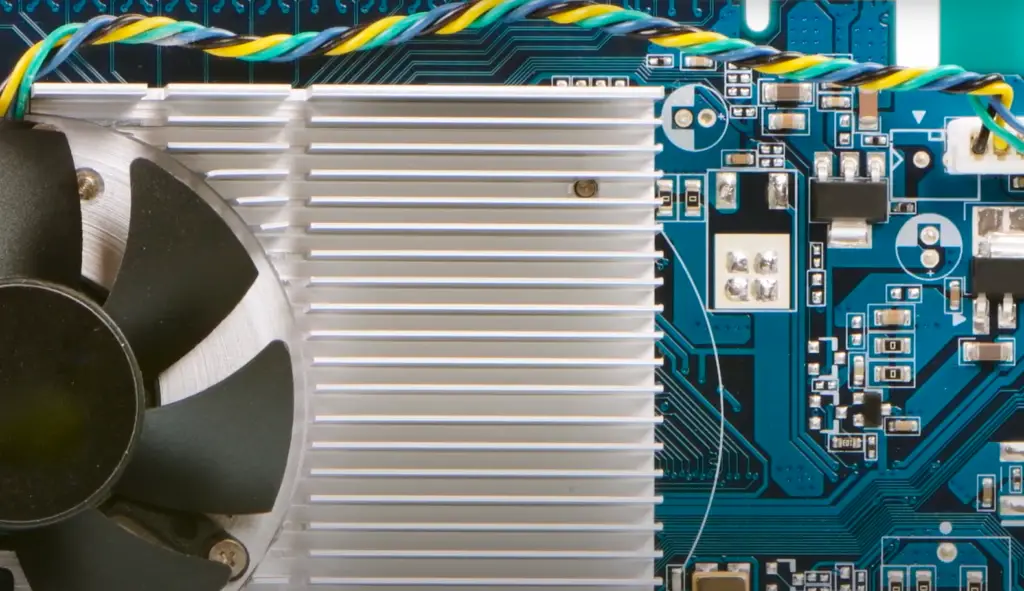
FAQ
1. How do you calculate heat sink performance?
The performance of a heat sink is calculated based on its thermal resistance, which is measured in degrees Celsius per watt (°C/W). The thermal resistance of a heat sink indicates how effectively it can dissipate heat from the component it is attached to.
It can be calculated using the formula R = (Tj – Ta)/P, where R is the thermal resistance, Tj is the temperature of the junction (the component being cooled), Ta is the ambient temperature, and P is the power dissipated by the component.
A lower thermal resistance indicates better heat dissipation and better performance of the heat sink [12].
2. How can the impact of heat on PCBs be minimized?
The impact of heat on PCBs can be minimized by using proper thermal management techniques such as using heat sinks, fans, thermal paste, and other cooling solutions. The PCB design should also consider the placement of components that generate heat and the routing of traces that carry high currents. Adequate ventilation and airflow should also be ensured. Using low-power components, optimizing the design for thermal performance, and using materials with low thermal resistance can also help minimize the impact of heat on PCBs.
3. What is a thermal simulation in PCB?
A thermal simulation in PCB is a computer-based modeling technique used to predict the temperature distribution and thermal behavior of a PCB design. Thermal simulation software uses algorithms to calculate the thermal characteristics of the PCB, including heat generation, dissipation, and transfer. It can be used to optimize the PCB design for thermal performance, identify potential hot spots, and evaluate the effectiveness of different cooling solutions such as heat sinks.
4. What is a heat sink and its purpose?
It is a metal device that is attached to the component or surface that needs cooling. The purpose of a heat sink is to absorb the heat generated by the component and dissipate it into the surrounding air, preventing the temperature from rising to a level that could damage the component.
5. Do I need a heat sink?
Whether or not you need a heat sink depends on the power dissipation of the electronic component and its operating temperature. High-power components, such as microprocessors and power transistors, generate more heat than low-power components and often require heat sinks to dissipate the heat effectively. It is always a good practice to consult the datasheet of the component and follow the manufacturer’s recommendations regarding cooling solutions.
6. What is a commonly used heat sink?
A commonly used heat sink is the extruded aluminum heat sink. These heat sinks are made from extruded aluminum and feature a large surface area with fins to increase heat dissipation. They are easy to manufacture and are relatively inexpensive compared to other types of heat sinks.
7. What are 5 uses of heat sinks:
- Cooling microprocessors in computers and other electronic devices;
- Dissipating heat generated by LED lighting systems;
- Cooling power transistors and other high-power electronic components;
- Preventing overheating in audio amplifiers and power supplies;
- Cooling motors in electric vehicles and other applications;
8. What is the location of a heat sink?
The location of a heat sink depends on the component that needs cooling. The heat sink is typically attached to the component using a thermal paste or a clip and placed in close proximity to the component. In some cases, multiple heat sinks may be used in a system, and they can be located on different parts of the PCB or even outside the device itself.
9. How are heat sinks installed?
Heat sinks are typically installed by attaching them to the component using a thermal paste or a clip. The heat sink is pressed firmly against the component to ensure good thermal contact. Thermal paste is used to fill any gaps or imperfections between the heat sink and the component, allowing for better heat transfer. Clips are used to hold the heat sink in place and ensure that it does not come loose. In some cases, heat sinks may be attached using screws or other fasteners, depending on the design of the component and the heat sink.
10. How many types of heat sinks are there:
- Extruded aluminum heat sinks;
- Stamped aluminum heat sinks;
- Bonded fin heat sinks;
- Folded fin heat sinks;
- Pin fin heat sinks;
- Zipper fin heat sinks;
- Liquid-cooled heat sinks;
The choice of heat sink type depends on the specific application and requirements of the component being cooled.
11. Can a heat sink overheat?
Although rare, a heat sink can overheat if the power dissipation of the component it is attached to exceeds the thermal capacity of the heat sink. This can happen if the heat sink is too small or if the airflow around it is inadequate. Overheating can also occur if the thermal paste between the heat sink and the component dries out or if the heat sink becomes detached or damaged.
12. Is a heat sink a cooler?
A heat sink is a type of cooler, specifically a passive cooler. It works by absorbing and dissipating heat from the component it is attached to, preventing the temperature from rising to a level that could damage the component. Other types of coolers include active coolers, such as fans and water-cooled systems, which actively remove heat from the component.
13. Does a heat sink absorb heat?
Yes, a heat sink absorbs heat from the component it is attached to, but it does not store it. The heat sink then transfers the absorbed heat to the surrounding air through convection, allowing the component to cool down.
14. Is a heat sink passive or active cooling?
A heat sink is a type of passive cooling. It does not actively remove heat from the component but rather absorbs and dissipates it into the surrounding environment through convection. In contrast, active cooling methods use an external energy source, such as a fan or pump, to actively remove heat from the component.
15. Can you touch a heat sink?
Yes, you can touch a heat sink, but it can be very hot to the touch. Heat sinks are designed to dissipate heat, so they can become very hot when in use. It is important to exercise caution and use protective equipment, such as gloves, when touching a heat sink that is in operation.
16. What happens if you touch a heat sink?
If you touch a heat sink that is in use, you can burn yourself. Heat sinks can become very hot, especially if they are attached to high-power components such as CPUs or power amplifiers. It is important to let the heat sink cool down before touching it or to use protective equipment when handling a hot heat sink.
17. How do you calculate heat sink performance?
Heat sink performance can be calculated using several factors, including the thermal resistance of the heat sink, the surface area of the heat sink, and the airflow around the heat sink. The thermal resistance is determined by the thermal conductivity of the material and the thickness of the heat sink. The surface area of the heat sink determines how much heat can be dissipated, while the airflow affects how quickly the heat is transferred from the heat sink to the environment.
The overall performance of a heat sink can be calculated using the formula:
Q = (Tj – Ta) / Rth
Where Q is the heat dissipated, Tj is the junction temperature of the component, Ta is the ambient temperature, and Rth is the thermal resistance of the heat sink [13].
Useful Video: How to Install ATS Push Pin Heat Sinks
References
- https://www.mclpcb.com/blog/heat-sink-pcb
- https://www.raypcb.com/heat-sink-pcb/
- https://www.twistedtraces.com/blog/an-overview-of-heat-sink-pcbs
- https://www.protoexpress.com/blog/12-pcb-thermal-management-techniques-to-reduce-pcb-heating/
- https://www.pcbbuy.com/news/How-to-Attach-Heat-Sink-to-PCB-through-the-5-Main-Methods.html
- https://www.mokotechnology.com/pcb-heatsink/
- https://resources.pcb.cadence.com/blog/2021-three-key-pcb-heat-dissipation-techniques
- https://tempoautomation.com/blog/how-to-choose-pcb-heat-dissipation-techniques/
- https://suntronicinc.com/blog/brief-on-heat-sink-pcbs/
- https://www.elprocus.com/different-types-of-heat-sinks-and-their-importance/
- https://madpcb.com/glossary/heat-sink/
- https://www.arrow.com/en/research-and-events/articles/understanding-heat-sinks-functions-types-and-more
- https://www.gabrian.com/6-heat-sink-types/





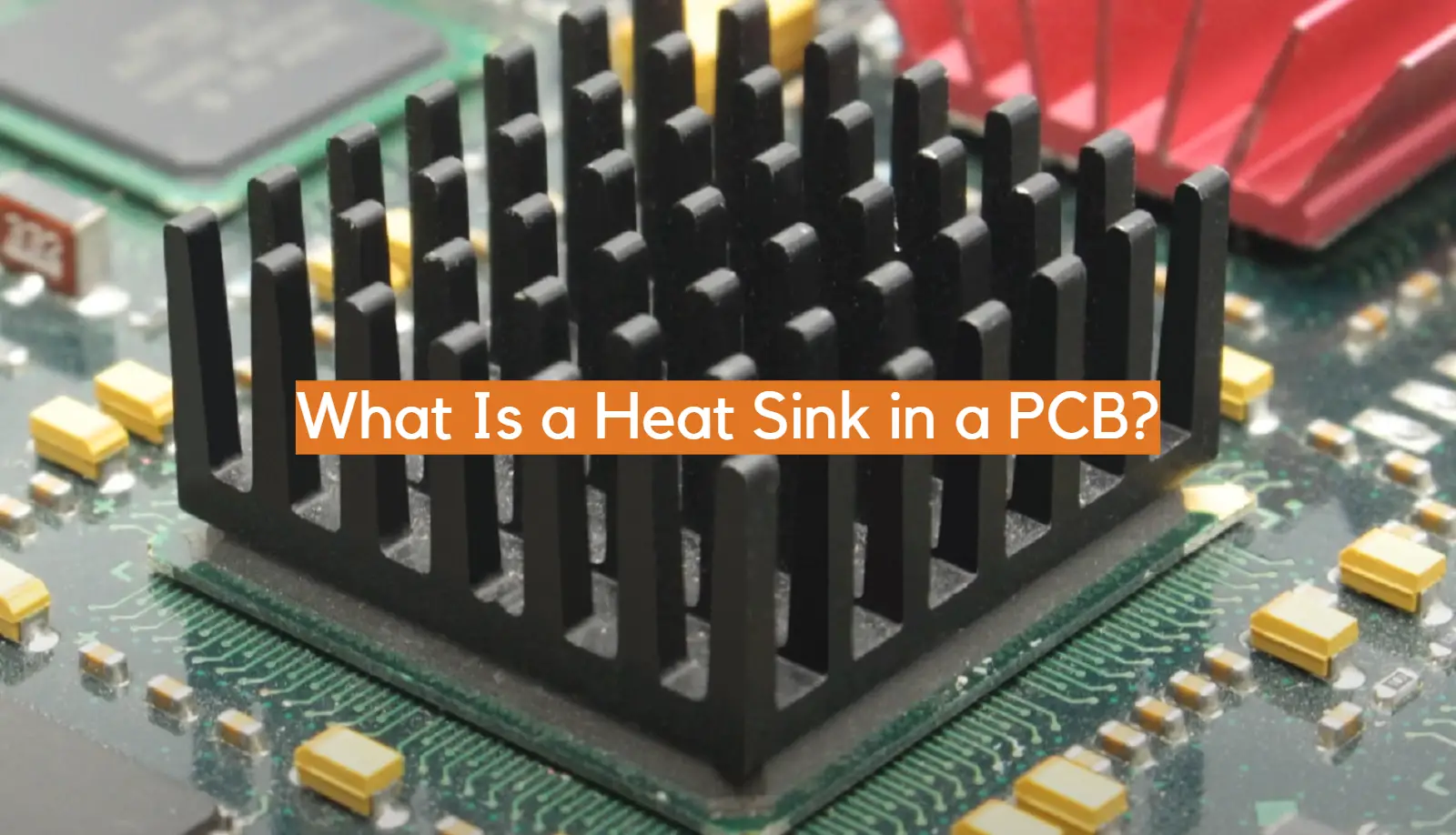







Leave a Reply